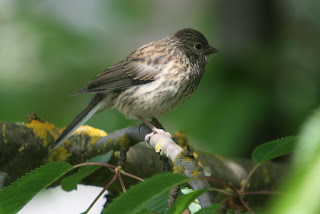For the past week or so, I've been seeing a couple of birds in my yard that I couldn't identify. It was hard to get a good look at them, and they looked enough like the sparrows that have been so common this spring that I was getting confused. As usual, my strategy was to take as many photos as possible and let Cannon sort it out.
sort it out.
Yesterday I finally got around to going through the recent photos and I discovered some surprises.
 The first mystery bird turned out to be pretty easy to identify. She (yes, in this case she is obviously she) posed for some great photos around the feeder. Her rather nondescript brown coloring had baffled me from a distance, but as soon as I got a good look at her head and beak I was pretty sure I knew who she was. It helps that I know her mate (at least, a male of her species) has been hanging around quite a bit lately. He's much more distinctive and I recognized him right away, even though I haven't gotten a really good photo of him yet. Earlier this year I even got a shot of the couple together on the feeder (or another couple a lot like them).
The first mystery bird turned out to be pretty easy to identify. She (yes, in this case she is obviously she) posed for some great photos around the feeder. Her rather nondescript brown coloring had baffled me from a distance, but as soon as I got a good look at her head and beak I was pretty sure I knew who she was. It helps that I know her mate (at least, a male of her species) has been hanging around quite a bit lately. He's much more distinctive and I recognized him right away, even though I haven't gotten a really good photo of him yet. Earlier this year I even got a shot of the couple together on the feeder (or another couple a lot like them). |
| This is the best photo I've managed to get of the male House Finch, but he is immediately recognizable. |
So my first mystery bird was a female House Finch. Even without her boyfriend's flashy colors, she's a handsome bird.
 |
| Earlier this spring, I got a picture of a House Finch couple at the feeder. |
The second contestant was harder to identify. I'm a little embarrassed to admit that, at first, I thought he (in this case I have no idea what the gender is) was a Song Sparrow. They're not quite as common in my neighborhood as House Sparrows, but they've been around this spring. He has a sparrow-ish shape, and brownish streaking on the breast. But it's not a Sparrow. I had to call in help from a naturalist friend to positively identify this one. Look at the photos and see if you can do better before you read on.
Identifying birds often comes down to details, and as my friend pointed out, the telling clue is in the tail. "See how one outer tail feather on each side of the tail is white?" He asked. "Can you think of a common backyard bird that you see with this pattern on the tail?"
Once you see that, it's a dead give-away. The flashing white tail feathers are so familiar that it's usually all I need to recognize one of my most loyal feeder birds: the Dark-eyed Junco. This little guy is a juvenile, probably a fledgling. And that makes him the first of the new generation that I've positively identified in my yard this year.
Pretty exciting news.
###
Birdland West readers will be interested in my review of Feathers: The Evolution of a Natural Miracle by Thor Hanson, which is posted now at Books and Beasts. It's a great book and a must read for all bird lovers. Check out the review here.
(Many of the original photographs featured on Birdland West are available for sale as art quality prints. You can check out all of our offerings at http://AlexWashoe.imagekind.com. If you see an image here that does not show up on our Imagekind site please contact me directly and I'll let you know about availability.)




No comments:
Post a Comment